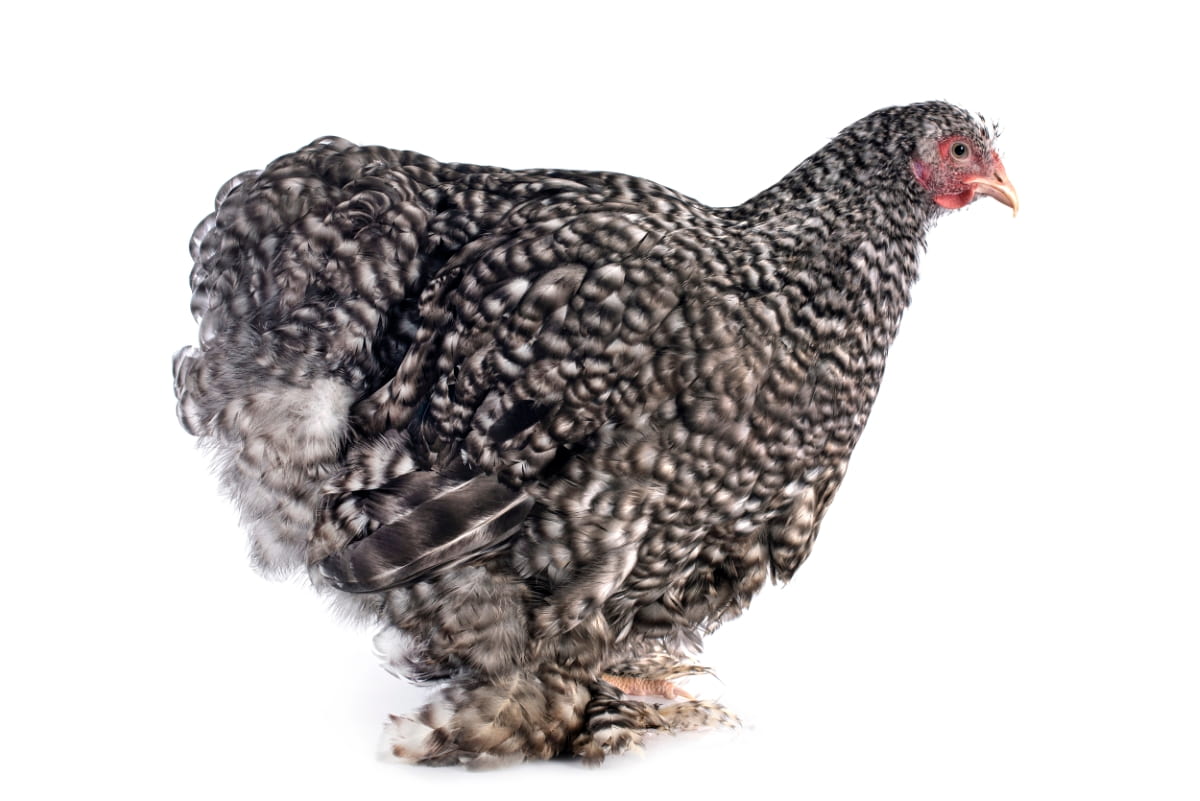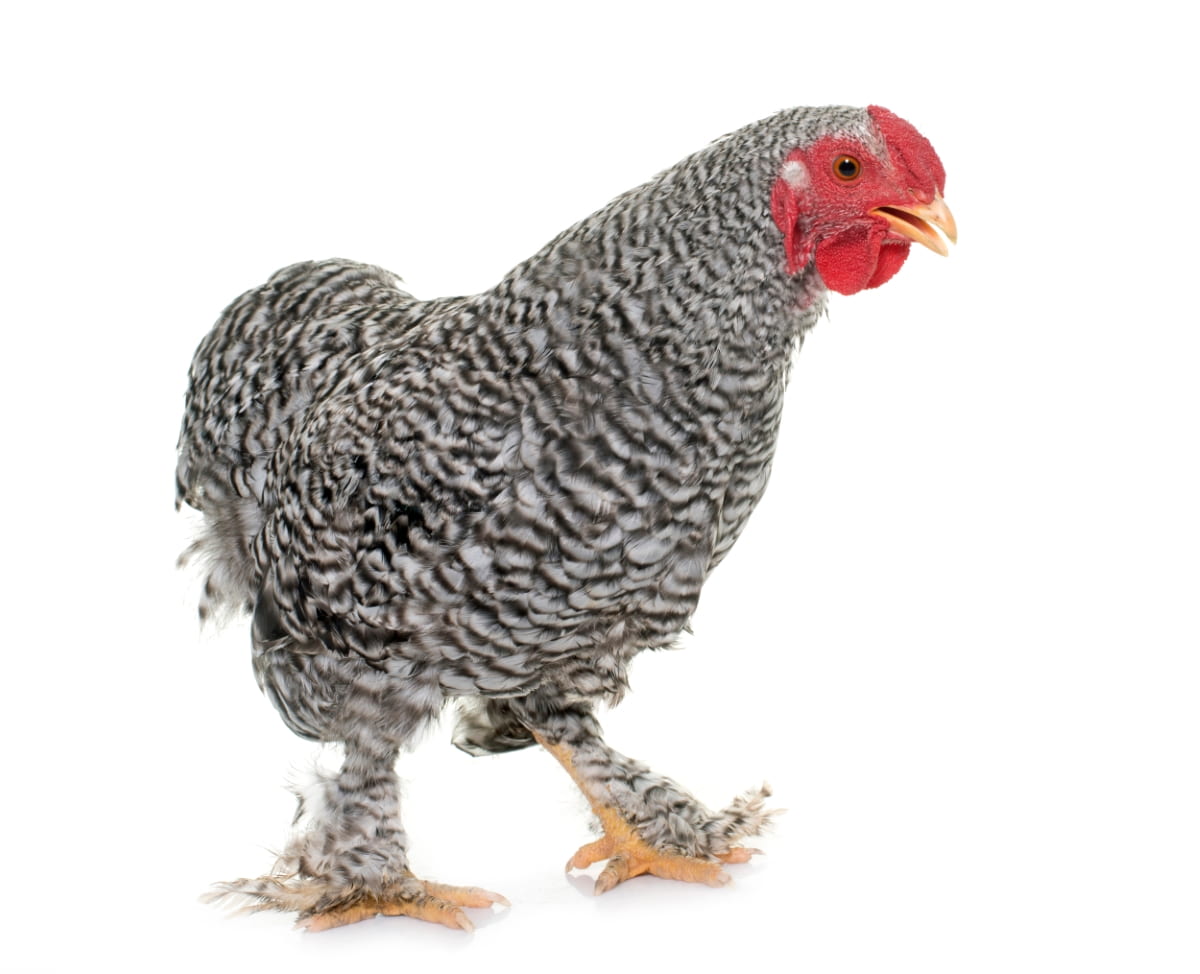Whether you’re seeking eggs, companionship, or simply ornamental appeal, these top 10 best fluffy chicken breeds are sure to bring joy to your homestead. Discover which fluffy chicken breeds are perfect for your backyard oasis, and start enjoying the perks of raising these delightful birds today!
Top 10 Fluffy Chicken Breeds
Silkie Chickens
Appearance and Characteristics
Silkie chickens feature fluffy feathers that resemble fur, along with black skin and bones. They have strikingly dark eyes and small, rounded combs. Their feathers lack barbicels, giving them a silky, soft texture. Silkie chickens are known for their gentle and friendly demeanor, making them popular as pets and show birds.
Silkie Chicken Care Guide and Housing Needs
Silkie chickens require a well-ventilated coop with bedding that’s kept clean and dry. Silkies are relatively small chickens, so they don’t require as much space as larger breeds, but they still need room to move around freely. Additionally, they should be protected from predators, as their docile nature makes them vulnerable.

Cochin Chickens
Distinctive Features and Size
Cochin chickens in backyards are easily recognizable by their large size and profuse plumage, which drapes over their bodies like a fluffy gown. Roosters can weigh up to a whopping 11 pounds, while hens typically reach around 8.5 pounds. Their size is accompanied by a majestic appearance, with fluffy feathers covering their bodies, including their feet.
Feeding and Maintenance Tips
Offer them a high-quality layer feed supplemented with fresh fruits, vegetables, and occasional treats like mealworms or scratch grains. Ensure they always have access to clean water. Due to their feathered feet, regularly check their feet for signs of injury or infection, especially if they are housed on damp ground.
In case you missed it: The Ultimate Guide for Olive Egger Chicken: Facts, Raising and Care

Faverolle Chickens
Breed Overview and Temperament
Faverolle chickens have a distinctive appearance with feathered legs, muffs, and a beard, giving them a charming and fluffy appearance. They are renowned for their docile and sociable nature, making them excellent additions to family flocks or backyard coops.
Health and Wellness Care
Providing a balanced diet rich in vitamins, proteins, and minerals is essential for their overall well-being and egg production in raising Faverolle chickens. Regular health checks, including monitoring for signs of illness or injury, are important to catch any issues early. Faverolles, like all chickens, require access to clean water and a safe, predator-proof coop for shelter.
In case you missed it: Rooster vs Hen: Key Differences to Identify Rooster and Hen Chicken

Orpington Chickens
Physical Traits and Behavior
Orpington chickens have a large, broad body with a low stance and fluffy feathers that give them a soft, rounded appearance. Orpington chicken breeds come in several color varieties, including buff, black, blue, and white. Orpingtons are known to be relatively calm and easygoing, often enjoying human interaction and attention.
Egg Production and Feeding
Orpington chickens are considered good layers, typically producing around 200 to 280 brown eggs per year, depending on the individual bird and environmental factors. Commercial poultry feed formulated for laying hens is recommended, supplemented with occasional treats like fruits, vegetables, and mealworms.
Brahma Chickens
Breed History and Size
Brahma chickens trace their roots back to the United States in the 1840s. Brahma chickens are notable for their impressive size, with roosters reaching weights of up to 12 pounds and hens averaging around 9 to 10 pounds. Their history and substantial size contribute to their regal appearance and popularity among poultry enthusiasts.
Climate Adaptability and Diet
Brahma chickens exhibit excellent adaptability to various climates, thanks in part to their large size and heavy feathering, which provides insulation against both cold and heat. A balanced diet consisting of commercial poultry feed supplemented with grains, fruits, vegetables, and occasional protein treats like mealworms or scraps ensures optimal health and performance.
Plymouth Rock Chickens
Plymouth Rock Chicken Overview
Plymouth Rock chickens have a distinctive black-and-white barred plumage pattern, with each feather displaying alternating bands of black and white. Plymouth Rocks are popular for their calm and docile nature. They are typically friendly and sociable birds, often enjoying human interaction and being comfortable around other flock members.
Raising and Handling
Raising Plymouth requires a well-ventilated coop with nesting boxes for egg-laying and roosts for perching at night. Providing a balanced diet consisting of commercial poultry feed supplemented with grains, greens, and occasional protein treats ensures their nutritional needs are met. Plymouth Rocks are generally easy to manage due to their gentle disposition.
Wyandotte Chickens
Breed Characteristics and Color Varieties
Wyandotte chickens are a popular breed known for their striking appearance and excellent qualities for backyard flocks. One of their most notable features is their striking plumage, which comes in a variety of color varieties including silver laced, golden laced, blue laced red, and black.
Broodiness and Egg Laying
Wyandotte chickens are known for their tendency towards broodiness, meaning they may exhibit a strong desire to sit on eggs and hatch chicks. Wyandottes are moderate to good layers, typically producing around 200 to 250 brown eggs per year, based on the individual bird and environmental factors. However, their broody tendencies may interrupt egg production during certain times of the year.
In case you missed it: Rumpless Game Chicken: Origin, Uses, Fighting Style, Price, and Characteristics, and Life Span

Frisian Chickens
Unique Features and Origin
Frisian chickens are a distinct Dutch breed known for their striking appearance and historical significance. Originating in the Friesland region of the Netherlands, these chickens have been bred for centuries for both ornamental and practical purposes. They are characterized by their striking black and white plumage, with sharply defined patterns that give them a regal and eye-catching appearance.
Care Requirements and Social Behavior
They require a well-ventilated coop with nesting boxes for egg-laying and roosts for perching at night. Providing a balanced diet consisting of commercial poultry feed supplemented with grains, greens, and occasional protein treats ensures their nutritional needs are met. Frisian chickens are known to be relatively calm and sociable birds. They typically get along well with other flock members and may enjoy human interaction.
Jersey Giant Chickens
Size and Growth Rate
Among the largest chicken breeds, Jersey Giants typically reach weights of 4 to 4.5 kg for hens and 4.5 to 6 kg for roosters. They are known to grow quickly, reaching their full size within a relatively short period compared to other breeds. Pullets, or young female chickens, usually reach weights of around 3.8 kg by the time they reach maturity.
Nutrition and Health Management
Commercial poultry feed formulated for large breeds or meat chickens is recommended, supplemented with occasional treats like fruits, vegetables, and protein sources such as mealworms for raising Jersey Giant chickens for backyards. Regular checking for signs of illness or injury maintaining a clean and dry environment, providing adequate ventilation, and practicing good biosecurity protocols help prevent common health issues like respiratory infections and parasites.
Buff Orpington Chickens
Breed Description and Fluffiness
Buff Orpington chickens have a medium to large size, with hens typically weighing around 3.2 to 3.8 kg and roosters reaching 3.8 to 4.7 kg.. What sets them apart is their soft, fluffy feathers that cover their entire body, giving them a plush and cuddly appearance. This fluffiness not only adds to their charm but also provides insulation, making them well-suited for colder climates.
Space and Environmental Needs
For optimal comfort and well-being, provide a minimum of 4 square feet of coop space per each chicken and at least 10 square feet of outdoor space in the run area. Ensure the coop is well-ventilated to prevent moisture buildup and respiratory issues, especially during colder months. Bedding such as straw or pine shavings should be provided and changed regularly to maintain cleanliness and prevent odor.
Conclusion
In conclusion, raising fluffy chicken breeds in your backyard can bring joy, companionship, and practical benefits. Whether you’re seeking eggs, meat, or simply delightful feathered friends, incorporating these top 10 fluffy backyard chicken breeds into your flock can enhance your homestead experience and create lasting memories for years to come.
- Feed Your Flock for Less: Top 10 Tips to Save on Chicken Feed
- Ultimate Guide to Ossabaw Island Hog: Breeding, Raising, Diet, and Care
- Hatching Answers: The Top 10 Reasons Your Chickens Aren’t Laying Eggs
- Eggs and Economics: Breaking Down the Cost of Raising Backyard Chickens
- Defend Your Greens: Proven Methods to Keep Iguanas Out of Your Garden
- Ultimate Guide to Cinnamon Queen Chicken: A Comprehensive Guide for Beginners
- Ultimate Guide to California Tan Chicken: Breeding, Raising, Diet, Egg-Production and Care
- Ultimate Guide to Marsh Daisy Chicken: Breeding, Raising, Diet, and Care
- 10 Types of Chicken Farming Businesses You Can Start for Profits